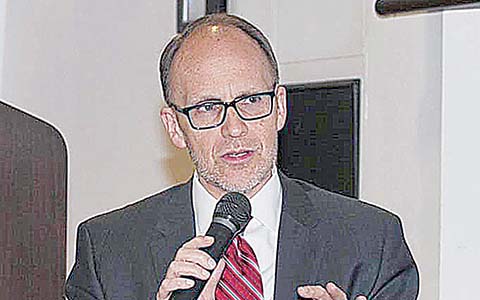 KUWAIT: US Ambassador to Kuwait Douglas Silliman speaks during the forum. —Photo by Yasser Al-Zayyat
KUWAIT: US Ambassador to Kuwait Douglas Silliman speaks during the forum. —Photo by Yasser Al-ZayyatKUWAIT: Twenty-five years after liberation, Kuwaitis are still thankful and emotional when talking about it, US Ambassador to Kuwait Douglas Silliman said at a forum organized by the US Embassy at the Gulf University for Science and Technology Wednesday evening. Speaking at the forum, which was also attended via Skype from Washington by former US Ambassador to Kuwait Edward 'Skip' Gnehm, Silliman noted that when he attends diwaniyas at schools and NGO events here, he is always reminded and thanked by many Kuwaitis for the role the United States played during the liberation of Kuwait in 1991.
"They talk about their own stories. Some are stories told to them by parents and by family members, and the gratitude accorded to the US-led coalition which liberated Kuwait has not been lessened. They are still expressing the same warmth and gratitude 25 years later," Silliman said. The forum, attended by GUST students, faculties and invited guests the under theme 'Liberation Day, 25 Years Later: Recollections of two American Ambassadors', was moderated by Mohamed Al-Ghanem, CEO of Alghanim and Sons.
Recalling the events which took place immediately after Iraqi forces retreated from Kuwait, Gnehm noted how gloomy and ugly the scene was, with many buildings and vehicles on the main highways on fire amidst celebrations on the streets of Kuwait, when it was finally liberated from Iraqi forces. Gnehm was the US ambassador to Kuwait during the Iraqi occupation and immediately after liberation. "I landed at the US embassy by helicopter, and before landing, I saw the gloomy face of Kuwait at that time. I was privileged to raise the American flag then - it was the greatest moment of my life. Outside the embassy was a parade of people celebrating and thanking us and the coalition forces. Our embassy at that time was next to the Kuwait Towers, so we were pretty close to the people, who were chanting 'We are free! Thank you coalition forces!' They were really excited," he recalled.
Silliman recalled his visits to Kuwait before and after the occupation. "I first came to Kuwait in 1988; then a few times in the 1990s and 2000s as a junior diplomat, so I have a sense of what it was to be in Kuwait. It's like coming home, especially now that I am the ambassador. The first impression, the friendliness and hospitality of Kuwaiti people 25 years later is very much alive when I visit Kuwaiti homes, schools and diwaniyas. Though the issues are much different now - not about rebuilding the country but more about economic and regional politics - the legacy of liberation and goodwill remains," he said.
Silliman was asked how the US government managed to convince the public that liberating Kuwait and military action was essential and a just cause. "It was difficult at first - there was no support from the US Congress and the public. There were lots of disagreements - the people and Congress wanted to pursue diplomatic efforts. The president was very adept and realized he did not have any backing, so he began working to change the attitude of people. Sheikh Sabah had been travelling around the world meeting leaders, and he and Washington gained the support of the public and many countries to pursue military action," he pointed out.
When the coalition was building, dialogue and coordination was very pivotal to the success of the operation. Gnehm was very active during the occupation, visiting the Kuwaiti government-in-exile and coordinating with then US President George Bush. "I met President Bush at the White House and then Sheikh Sabah (the then Kuwaiti foreign minister). It is still vivid in my mind when President Bush asked Sheikh Sabah: "Is there anything I can do for you," and Sheikh Sabah responded, "Yes, please help me plan for the rebuilding and reconstruction of my country and my people," so we organized and readied the plan," he said.
By Ben Garcia










